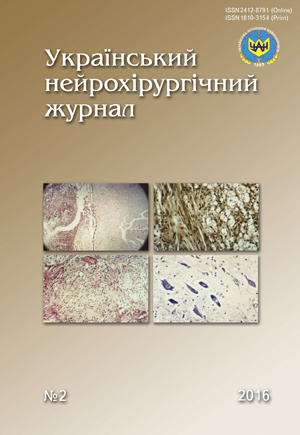Pecularities of the corpus callosum vascularization for microsurgical callosotomy in patients with severe symptomatic epilepsy
DOI:
https://doi.org/10.25305/unj.72609Keywords:
symptomatic epilepsy, seizures, callosotomy, corpus callosum, anterior cerebral arteryAbstract
Aim. Evaluate of the efficacy and safety of microsurgical callosotomy in the early postoperative period, taking into account the features of the vascularization of the corpus callosum in the surgical treatment of severe symptomatic epilepsy.
Material and methods. In study were enrolled 13 children with drug-resistant epilepsy aged from 2 t 16 years (mean 7.3 ± 2.8 years) who underwent callosotomy. At the time of the surgery frequency of seizures was 20.3 ± 9.8 per day, 11 from 13 (84.6%) had repeated status epilepticus. Six (46.2%) had one-stage total callosotomy and 7 (53.8%) underwent anterior callosotomy. Postoperative follow-up was from 8 to 30 moths (mean - 16.7 ± 3.6 months).
Results. After surgery 4 (30.8%) were seizure-free (Engel scale – 1), 5 (38.5%) had rare short auras (Engel scale – 2), in 3 (23.0%) cases the seizure frequency significantly reduced – over 80%. In 1 (7.7) child who had Rasmussen encephalitis secondary generalised seizures were stopped but partial motor fits persist (Engel scale – 4).
Conclusion. Callosotomy is effective and safe methods of treatment severe epilepsy. Positive outcome is caused by establishing the correct indications for surgery and application of modern microsurgical equipment, taking into account topographic and anatomic features of the blood supply of the corpus callosum.
References
1. Panayaiotopoulos C.P. A сlinical guide to epileptic syndromes and their treatment. 2nd ed., revised. Springer Healthcare Ltd., 2010.
2. Kwan P, Arzimanoglou A, Berg AT, Brodie MJ, Allen Hauser W, Mathern G, Moshй SL, Perucca E, Wiebe S, French J. Definition of drug resistant epilepsy: consensus proposal by the ad hoc Task Force of the ILAE Commission on Therapeutic Strategies. Epilepsia. 2010;51(6):1069-77. [CrossRef] [PubMed]
3. Kayyali H, Abdelmoity A, Baeesa S. The role of epilepsy surgery in the treatment of childhood epileptic encephalopathy. Epilepsy Research and Treatment. 2013:1-6. [CrossRef]
4. Delalande O, Bulteau C, Dellatolas G, Fohlen M, Buret V, Viguier D, Dorfmuller G, Jambaque I. Vertical parasagittal hemispherotomy: surgical procedures and clinical long-term outcomes in a population of 83 children. Neurosurgery. 2007;60(2):19-32. [CrossRef] [PubMed]
5. Beier AD, Rutka JT. Hemispherectomy: historical review and recent technical advances. Neurosurg Focus. 2013;34(6):1-5. [CrossRef] [PubMed]
6. Devinsky O, Laff R. Callosal lesions and behavior: History and modern concepts. Epilepsy&Behavior. 2003;4:607–17. [CrossRef] [PubMed]
7. Jenssen S, Sperling MR, Tracy JI, Nei M, Joyce L, David G, O’Connor M. Corpus callosotomy in refractory idiopathic generalized epilepsy. Seizure. 2006;15(8):621–9. [CrossRef] [PubMed]
8. Kwan SY, Shyu HY, Lin JH, Wong TT, Chang KP, Yiu CH. Corpus callosotomy in a patient of hemimegalencephaly and Lennox-Gastaut syndrome. Brain Dev. 2008;30(10):643–6. [CrossRef] [PubMed]
9. Luessenhop AJ. Interhemispheric commissurotomy: (the split brain operation) as an alternate to hemispherectomy for control of intractable seizures. Am. Surg. 1970;36:265-8. [PubMed]
10. Kasasbeh AS, Smyth MD, Steger-May K, Jalilian L, Bertrand M, Limbrick DD. Outcomes after anterior or complete corpus callosotomy in children. Neurosurgery. 2014;74(1):17-28. [CrossRef] [PubMed]
11. Park MS, Nakagawa E, Schoenberg MR, Benbadis SR, Vale FL. Outcome of corpus callosotomy in adults. Epilepsy Behav. 2013;28(2):181-4. [CrossRef] [PubMed]
12. Jalilian L, Limbrick DD, Steger-May K, Johnston J, Powers AK, Smyth MD. Complete versus anterior two-thirds corpus callosotomy in children: analysis of outcome. J Neurosurg Pediatr. 2010;6(3):257–66. [CrossRef] [PubMed]
13. Feichtinger M1, Schrцttner O, Eder H, Holthausen H, Pieper T, Unger F, Holl A, Gruber L, Kцrner E, Trinka E, Fazekas F, Ott E. Efficacy and safety of radiosurgical callosotomy: a retrospective analysis. Epilepsia. 2006;47(7):1184–91. [CrossRef] [PubMed]
14. Roberts DW, Rayport M, Maxwell RE. Corpus callosotomy. In: Engel J, editor. Surgical treatment of the epilepsies. New Yourk: Raven Press; 1993. p.519–26.
15. Sunaga S, Shimizu H., Sugano H. Long-term follow-up of seizure outcomes after corpus callosotomy. Seizure. 2009;18(2):124–8. [CrossRef] [PubMed]
16. Stigsdotter-Broman L, Olsson I, Flink R, Rydenhag B, Malmgren K. Long-term follow-up after callosotomy — a prospective, population based, observational study. Epilepsia. 2014;55(2):316-21. [CrossRef] [PubMed]
17. Fischer E. Die Lageabweichungen der vorderen Hirnarterie im Gefassbild. Zentralbl Neurochir. 1938;3:300-12. German. https://www.thieme-connect.com/products/ejournals/linkout/10.1055/s-0030-1253577/id/14
18. Perlmutter D, Rhoton Jr AL. Microsurgical anatomy of the anterior cerebral-anterior communicating-recurrent artery complex. J Neurosurg. 1976;45(3):259-72. [CrossRef] [PubMed]
19. Gomes FB, Dujovny M, Umansky F, Berman SK, Diaz FG, Ausman JI, Mirchandani HG, Ray WJ. Microanatomy of the anterior cerebral artery. Surg Neurol. 1986;26(2):129-41. [PubMed]
20. Yasargil MG. Operative anatomy, in Microneurosurgery. Stuttgart: Georg Thieme Verlag; 1984;1. p.5-168.
21. Miller JW, Silbergeld DL Epilepsy surgery: principles and controversies. New York: Taylor & Francis Group, LLC; 2006.
Downloads
Published
How to Cite
Issue
Section
License
Copyright (c) 2016 Kostyantyn Kostiuk, Mykhaylo Kostiuk, Valeriy Cheburakhin, Sergiy Dichko, Sergiy Minov

This work is licensed under a Creative Commons Attribution 4.0 International License.
Ukrainian Neurosurgical Journal abides by the CREATIVE COMMONS copyright rights and permissions for open access journals.
Authors, who are published in this Journal, agree to the following conditions:
1. The authors reserve the right to authorship of the work and pass the first publication right of this work to the Journal under the terms of Creative Commons Attribution License, which allows others to freely distribute the published research with the obligatory reference to the authors of the original work and the first publication of the work in this Journal.
2. The authors have the right to conclude separate supplement agreements that relate to non-exclusive work distribution in the form of which it has been published by the Journal (for example, to upload the work to the online storage of the Journal or publish it as part of a monograph), provided that the reference to the first publication of the work in this Journal is included.









